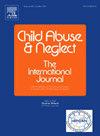Diverging paths: Health-care inequities by age among sexually abused children with disabilities
IF 3.4
2区 心理学
Q1 FAMILY STUDIES
引用次数: 0
Abstract
Objective
This study investigated disparities in health and health-care outcomes between children with disabilities who have experienced sexual abuse and children without disabilities having such experiences, considering different stages of childhood and adolescence.
Methods
We utilized linked national datasets from Taiwan, leveraging comprehensive population-level data to analyze age-specific differences in health-care utilization. Eleven postassault health-care outcomes were analyzed, including mental health visits, pediatric and ophthalmology outpatient visits, obstetrics and gynecology care, pregnancy-related visits (3 indicators), self-harm, emergency room visits, general outpatient utilization, and total medical expenditure.
Results
Among 19,133 sexually abused children, 7.4 % had a documented disability. Children with disabilities were more likely than those without disabilities to be from low-income families. Mental health outpatient visits were significantly higher among children with disabilities, particularly at younger ages (eg, 4.53 additional visits at age 1 [P < .001]), with the effect weakening with age. By contrast, younger children with disabilities had significantly fewer general and ophthalmology outpatient visits. Disability was associated with decreased use of pregnancy-related services at older ages and had no significant effect on self-harm or emergency room visits. Total medical expenditure was higher for children with disabilities, and disparities increased with age.
Conclusion
In children with disabilities who have experienced sexual abuse, health-care utilization varies across age groups. These findings highlight a need for age-sensitive and disability-informed responses to trauma.
不同的道路:在遭受性虐待的残疾儿童中按年龄划分的保健不平等
目的本研究调查了经历过性虐待的残疾儿童和有过此类经历的非残疾儿童在健康和保健结果方面的差异,考虑了儿童和青少年的不同阶段。方法:我们利用台湾相关的国家数据集,利用全面的人口水平数据来分析医疗保健利用的年龄特异性差异。分析了11项攻击后保健结果,包括心理健康就诊、儿科和眼科门诊就诊、妇产科护理、妊娠相关就诊(3项指标)、自残、急诊室就诊、普通门诊使用率和医疗总支出。结果在19133名被性侵儿童中,7.4%有残疾记录。残疾儿童比非残疾儿童更有可能来自低收入家庭。残疾儿童的心理健康门诊诊断率显著较高,尤其是年龄较小的儿童(例如,1岁时的诊断率为4.53次[P <; .001]),随着年龄的增长,这种影响逐渐减弱。相比之下,年龄较小的残疾儿童去普通科和眼科门诊就诊的次数明显减少。残疾与老年妇女使用妊娠相关服务的减少有关,对自残或急诊室就诊没有显著影响。残疾儿童的医疗总支出较高,而且差距随着年龄的增长而扩大。结论在遭受过性虐待的残疾儿童中,不同年龄组对保健服务的利用情况不同。这些发现强调了对创伤做出年龄敏感和残疾知情反应的必要性。
本文章由计算机程序翻译,如有差异,请以英文原文为准。
求助全文
约1分钟内获得全文
求助全文
来源期刊

Child Abuse & Neglect
Multiple-
CiteScore
7.40
自引率
10.40%
发文量
397
期刊介绍:
Official Publication of the International Society for Prevention of Child Abuse and Neglect. Child Abuse & Neglect The International Journal, provides an international, multidisciplinary forum on all aspects of child abuse and neglect, with special emphasis on prevention and treatment; the scope extends further to all those aspects of life which either favor or hinder child development. While contributions will primarily be from the fields of psychology, psychiatry, social work, medicine, nursing, law enforcement, legislature, education, and anthropology, the Journal encourages the concerned lay individual and child-oriented advocate organizations to contribute.
 求助内容:
求助内容: 应助结果提醒方式:
应助结果提醒方式:


